Metallic Sun-orchid
Metallic Sun-orchidThelymitra epipactoides | |
|---|---|
| Kingdom: | Plantae |
| Phylum: | Magnoliophyta (Angiosperm) |
| Class: | Magnoliopsida (Monocotyledon) |
| Subclass:: | Liliidae |
| Order | Orchidales |
| Family: | Orchidaceae |
| Status | |
| World: | Endangered (IUCN) |
| Australia: | Endangered |
| Victoria: | Endangered (FFG Threatened List 2025) |
| FFG: | Listed; Action Statement No. 156 |
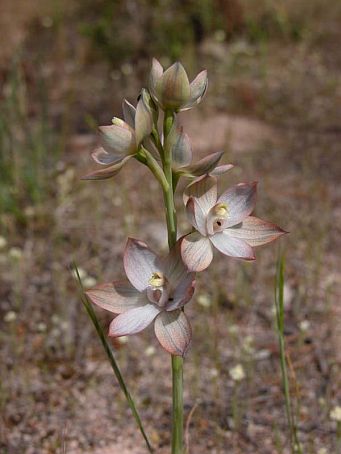
The Metallic Sun-orchid (Thelymitra epipactoides) is one of the largest and most impressive of the Thelymitra. It grows from a subterranean tuberous root and when fully developed has a single, erect, sheathing leaf to 25cm and a flower stem to 50cm tall which contains 5-20 flowers. Flower colour is highly variable, brown, copper, blue and green being the main colour groups which are determined by the proportion of red, blue and green epidermal cells, some of which are reflective giving a metallic appearance.
A sweet scent is produced when flowers open, usually in Sptember - October and only on warm sunny days with low humidity. Mature non-flowering plants produce a single, erect, linear-lanceolate leaf to 51cm tall. Immature plants produce a linear leaf to about 30cm, usually on an acute angle to the ground (Cropper et al 1989, Cropper & Calder 1989, Backhouse & Jeanes 1995).
Distribution
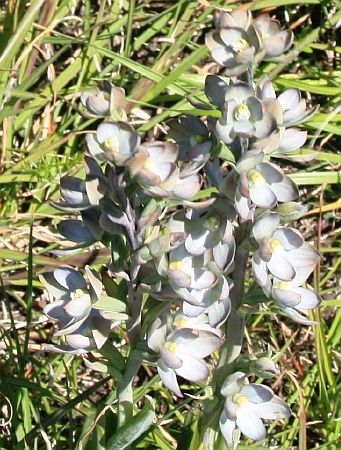
Image: Noushka Reiter
The Metallic Sun-orchid is distributed in southern Victoria and southeastern South Australia. It was once widespread along coastal areas of Victoria from Gippsland to the far Southwest and extending inland to the Wimmera. Remaining populations are now isolated and mainly confined to parks and reserves. Apart from a few populations in the coastal areas of Gippsland such as the Gippsland Lakes Coastal Park, Blond Bay Wildlife Reserve and at Golden Beach the south-west region of Victoria contains the majority of remaining sites. Significant areas are Port Campbell National Park, Bay of Islands Coastal Park, the Tooloy-Lake Mundi Wildlife Reserve, the Kiata Flora & Fauna Reserve and sections of the Grampians National Park in the Wimmera. In Gippsland, Blond Bay Wildlife Reserve and Gippsland Lake Coastal Park are important areas for this species.
Many sites are no longer viable or in a state of decline e.g. No sightings have been seen in Mocamboro Flora Reserve or the Lower Glenelg National Park for the last five years (Pitts pers. comm.) despite extensive surveying with the Australian Native Orchid Society between 2009-2011. The plants in Port Campbell are thought to be in decline as a result of increased biomass due to inappropriate fire regimes, invasion of coast wattle and increased browsing.
Population estimates vary from about 1050 plants in Australia (DEH 2006), to less than 3,000 plants (Coats et al 2002). More recent assessments suggest the population could be less than 1500 plants in the wild which comprise seven main populations in Victoria.
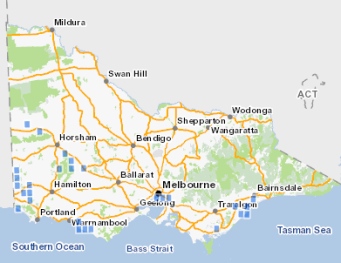
Source: DEPI Victorian Biodiversity Atlas, accessed 29 August 2014.
Ecology & Habitat
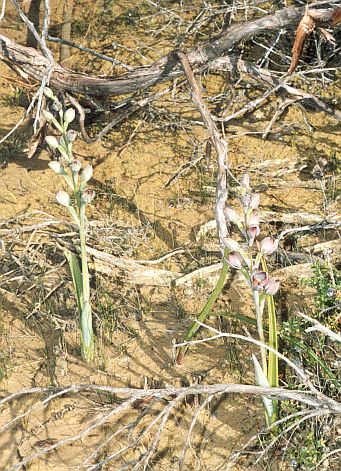
Typical habitat utilising bare area under
dead vegetation
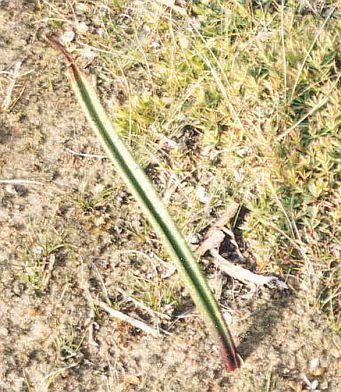
Metallic Sun-orchid non flowering mature form
Key habitat characteristics are sub-humid environments where there may be a period of water stress in the summer and cool to wet winters in which soils comprising sandy loams overlying a clay subsoil have a tendency to become waterlogged.
The Metallic Sun-orchid also favours stable mature open heathland vegetation communities close to the coast where there is a mosaic of disturbed sites. These areas are often dominated by;
- Manuka Leptospermum scoparium,
- Guinea-flower Hibbertia truncata,
- Swamp Weed Selliera radicans,
- Common Bog-rush Schoenus apogon,
- Coast Beard-heath Leucopogon parviflorus,
- sometimes in association with native grassesThemeda australis and Poa poifrmis.
Immature plants have been observed growing around old Leptospermum stumps.
The inland site near Casterton is dominated by; Prickly Tea-tree Leptospermum juniperinum in association with sedgelands which provide more favourable habitat. At Kiata, open shrubland is dominated by Wattles Acacia sp. with a shrubby ground cover of Flame Heath Astroloma conostephioides. The Metallic Sun-orchid is also found in association with a mycorrhizal fungi Tulasnella asymmetrica that may assimilate nutrients for the orchid (Cropper et al 1989, Calder et al 1989).
Growth
The Metallic-sun orchid has a dormant period between January to March, during this period the leaf and flower stem wither, this may assist the orchid in coping with events such as water stress during dry conditions and also avoid the likelihood of being damaged by fire. Generally by April a single leaf emerges, the flower stem develops in August and is fully mature during October, ( flowering can occur from September to November depending on the season and site conditions). By December the seeds are fully developed.
Reproduction
The Metallic Sun-orchid regenerates almost exclusively from seed that falls on sites where soil or plant community disturbance has occurred. Typical examples are; opening of canopy through death of structurally dominant plants, salt induced dieback, digging by fauna such as echidnas, regular but infrequent fires, browsing and trampling by Kangaroos and Wallabies. Also minor land management activities such as track works may assist in opening up small areas, however this also comes with an added risk of introducing the spread of invasive weeds.
The flower colour and scent attract insects which provide pollination, although there is no obvious reward for pollinators as no nectar is produced. Native bees, genus Nomia are known to pollinate the Metallic Sun-orchid, in effect they are deceived by the flower’s colour and scent. The variety of flower colours within this species may also act as a means of ensuring pollinators remain attracted to the flower despite there being no nectar (Cropper & Calder 1989).
Threats
Weed invasion
The spread of Acacia longifolia into coastal heathlands has been identified as an issue. Any form of weed invasion that smothers out light or prevents the opportunity for seed to germinate on small areas of bare ground is of concern. Weed invasion often results from disturbance to soil and vegetation, particularly where there is already a weed source in the vicinity and there is mechanical disturbance such as grading, digging etc. Weeds are often spread along walking tracks and vehicle tracks and have the potential to invade suitable orchid habitat.
Changes to soil and water regimes
Common causes are construction or changes to road or tracks or drainage of areas which can impact on the surface or sub-surface movement of water and alter the natural cycle of seasonal waterlogging and drying out of sandy loams, this being one of the habitat requirements necessary to support the Metallic Sun-orchid.
Reduced recruitment
Reduced seed production and impaired seed germination can be caused by changed ecological conditions, e.g. lack of occasional fires. Long term changes to the floristic composition of habitat can result in the loss of heathlands due to the expansion of structurally dominant species. This can alter the natural mosaic of small disturbed areas suitable for seedling development. A lack of occasional fires can also retard the floristic diversity of an area and reduce pollinators that are necessary for successful seed development. Hand pollination has been carried out with some success to overcome a lack of natural pollinators.
Grazing of flower stems
Grazing by stock or native herbivores such as the Kangaroo and Wallaby can cause sever browsing damage. At some locations this has been identified as a major problem as it can severely impact on the production of seed for future recruitment of the orchid. Deer and the European Rabbit are also recognised as a problem in browsing flower stems. There are cases where the entire flowering crop of a local population has been wiped out due to rabbits (Cropper et al 1989).
Grazing by slugs
Chrysomelid Beetle lavae and Tortricid Moth lavae have been observed to graze on leaf material leading to the loss of leaf (Cropper et al 1989).
Physical damage by humans
Physical damage includes trampling of plants and digging out plants. Trampling can be a major problem at high visitor areas as the delicate flower stems are easily damaged. Digging out plants is illegal as this species protected under under the Flora & Fauna Guarantee Act 1988, it results in the loss of plants which can impact on recruitment potential. It also assists the spread of invasive weeds into areas which can limit the viability of local populations.
Conservation & Management
Key actions necessary to maintain the viability of this species, identified by Calder et al 1989.
- Maintain soil and water regimes
- Provide periodic opening of the heathland canopy to create a mosaic of disturbed areas for seedling establishment through burning of small areas prior to emergence of the orchid in early March, occasional slashing may be a suitable alternative to burning.
- Establish physical protection against browsing.
Specific actions identified by the Department of Environment and Primary Industries, Victoria
These actions are undertaken by DEPI and partners such as Parks Victoria, Australian Native Orchid Society, Australian Orchid Foundation, RMIT University, University of Melbourne, Royal Botanic Gardens, CMA's, Horsham Orchid Propagation Facility, Community groups including: the Portland Field Naturalist, the Bairnsdale and Districts Field Naturalists and the Grampians Threatened Species Group and individual naturalists have all been actively involved in the recovery program for this species.
Research - management and biology
- Undertake research to identify key biological functions
- Identify ecological correlates of key populations. Undertake assessment by conducting detailed analyses of the environmental attributes of habitats where orchids are abundant, sparse or absent. Analyse the condition of the ground layer, the role of soil physical properties and the implications for soil moisture retention.
- Determine the effects of artificial pollination on growth, survival and reproduction.
- Evaluate natural pollination levels and/or causes of pollinator limitation.
- Prepare descriptions of critical, common and potential habitat using environmental and bioclimatic data. Identify environmental conditions that foster mutualistic relationships between orchids and other organisms that promote flowering, seed set and recruitment.
Population monitoring
- Conduct annual censusing of populations. Collect demographic information such as recruitment and mortality, dormancy periods and the timing of life history stages for key populations.
- Collate, analyse and report on census data.
Ex situ plant conservation
- Maintain ex situ collections for display, research or insurance against losses
- Seed has been collected from Blonde Bay, Bay of Islands Coastal Park, Lake Mundi and Kiata FFR to establish a threatened orchid seed bank and determine seed viability.
- A mycorrihizal fungi bank has been established.
Additional actions at priority locations
Western Victoria
Grampians National Park
- Conduct survey: vegetation and environmental characteristics associated with key populations will be surveyed and used to document causes or potential causes of decline, identify disturbance requirements, for designing surveys for potential populations, and to prepare habitat descriptions
- Re-stock populations with seed in autumn.
- Cage plants to protect from grazing.
Kiata Flora and Fauna Reserve
- A survey of vegetation at the site was completed in 2011.
- 30-40 plants are located within the Kiata FFR. A re-introduction of several hundred plants was planned for June 2011.
- Mycorrhizal fungi has been collected with assistance of the the Australian Orchid Foundation.
- In 2011/12 hand pollinated seed was collected for propagation at the Horsham Orchid Propagation Laboratory.
- Parks Victoria undertakes rabbit and weed control to protect orchid populations.
- Parks Victoria have closed or re-routed tracks at a number of sites to protect orchids from vehicles.
- Every year DEPI monitors the populations to identify and implement strategies to control threats.
Tooloy-Lake Mundi Wildlife Reserve
- Control high-priority weed species.
- Control the likelihood of accidental damage. Closure or re-routing of tracks at a number of sites will direct four wheel drive traffic away from sensitive populations. Walking tracks also need to be realigned in some cases.
- Mycorrhizal fungi for ex-situ propagation was collected in 2009.
- Establish and maintain a translocated population.
- Continue to propagate plants as per translocation plan until sufficient genetic resources are achieved in reintroduction population .
- A small burn was conducted on a selected area in 2007.
- Manage environmental weeds - mostly pine wildlings. A woody weed control program targeting pine wildlings commenced in 2014 within Lake Mundi Wildlife Reserve.
- Continue to implement existing long term demographic monitoring program first established in 2010.
Lower Glenelg National Park
- Conduct annual censusing of populations.
- Control high-priority weed species.
- Re-stock populations with seed in autumn.
- Prepare habitat for seedling recruitment.
- Control the likelihood of accidental damage. Closure or re-routing of tracks at a number of sites will direct four wheel drive traffic away from sensitive populations. Walking tracks also need to be realigned in some cases.
Mocamboro Flora Reserve
- Population monitoring is undertaken each year but plants have not been seen at this location for a few years despite historic records of good populations.
- Activities to prepare the site for seedling recruitment involved burning and removal of pine trees in 2007.
Wilkin Flora & Fauna Reserve
- Activities at this site have been reduced with more focus on high priority sites.
- Control high-priority weed species.
- Control native animals to reduce grazing
- Prepare habitat for seedling recruitment.
Bay of Islands Coastal Park
- Undertake site specific ecological burning every 5-7 years.
- Every year assess threats including herbivores, insects, biomass accumulation, environmental weeds, visitor impacts.
- Control of grazing animals and maintain protective cages as required.
- Assess weed threat. If necessary control high-priority weed species.
Port Campbell National Park
- Undertake ecological burning with a 5 year interval for Metallic Sun-orchids.
- Ecological burns targetted at Metallic Sun-orchid were conducted in 2004 & 2005 and during the Summer/Autumn 2012 with further burns planned.
- Every year assess habitat characteristics and/or condition. In 2013 poor results were due to high biomass accumulation.
- Prepare habitat for seedling recruitment.
- Re-stock populations with seed in autumn.
- Control introduced animals to reduce grazing and cage plants
- Control high-priority weed species.
Gippsland
Blond Bay Wildlife Reserve
- Burn specific orchid area every four years.
- Seed has been collected for herbarium.
- In 2012 a mycorrhizal fungi bank was established.
- Signs are to be placed around fenced areas alerting public that it is a research site, requesting no disturbance.
- Detailed population monitoring and collect demographic information has been completed.
- There will be further work to identify disturbance regimes to promote regeneration and recruitment.
Dutson Downs Pipeline Block - Gippsland Water
- An reintroduced / translocated population has been established which requires on-going matinenance.
- Department of Environment and Primary Industries works in partnership with Australian Native Orchid Society and volunteers in the translocation program.
- Undertake weed control (principally Spiny Rush) at reintroduction site.
- Propagate seedlings to supplement initial plantings at Dutson Downs.
Gippsland Lakes Coastal Park
- Every year DEPI to monitor populations, identify and implement strategies to control threats.
- DEPI to collect seed for use in ex-situ propagation.
- In 2004 Parks Victoria organised surveys to acquire baseline population data.
- A seasonal mowing program is conducted by Parks Victoria to reduce biomass accumulation and promote regeneration and recruitment.
Update on management activities
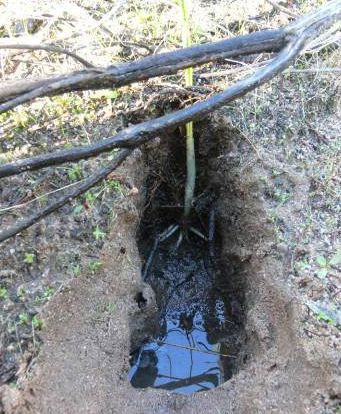
Digging to collect root material containing
mycorrhizal fungi.
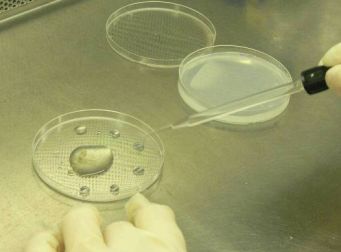
Mycorrhizal isolates being harvested from root material. This involves isolating peletons which can be grown on sterile medium. More about how mycorrhizal fungi are used. See: Orchid mycorrhizal fungi: identity and diversity of fungi from Victorian endangered orchid species
341.jpg)
Successful growth of the first germinants of Metallic Sun-orchid, 3 months old.
341.jpg)
Metallic Sun-orchids in the laboratory 6 months old.
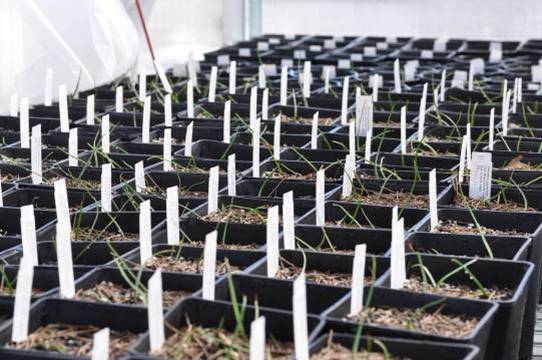
Metallic Sun-orchids in the laboratory 12 months old.
In 2010 a draft re-introduction plan was developed for Thelymitra epipactoides and circulated amongst the Recovery Team for comment. This plan sets out the most important activities to be undertaken to ensure recovery of this species.
A monitoring system of recording demographic information such as leaf emergence, flowering, pollination, grazing and recruitment has been established across three Metallic Sun-orchid sites in western Victoria Lake Mundi, Kiata, Flaxman’s Hill and Port Campbell. Ongoing comparative data from these three sites will be used to further define management actions and priorities for this species.
In 2010 a collaborative research project was initiated as part of an Australian Orchid Foundation project with RMIT University, University of Melbourne, Royal Botanic Gardens and DSE. The project will run for three years and will investigate the edaphic conditions experienced by Metallic Sun-orchids, the identity and diversity of mycorrhizal populations associated with these populations, whether mycorrhizal fungi form tripartite links with associated flora, and the optimal in-vitro germination and nursery growth conditions to raise these plants.
A collection of approximately 3,000 propagated plants is being maintained at the Horsham Orchid Propagation Facility genetic material sourced from Lake Mundi, Kiata and Port Campbell. These are now ready for introduction into the wild, commencing in the Wimmera July 2012.
Wimmera
International Student Volunteers and DSE Land and Fire Indigenous trainees completed weed and rabbit management works in preparation for a re-introduction in July 2011.
At Kiata, all 15 plants in which flowered were individually cross pollinated and parentage setting seed recorded. Seed from these plants were harvested for propagation and the site was re-stocked with seed in autumn. Ten root samples were harvested from plants throughout the reserve and taken to the Horsham Orchid Facility to isolate the mycorrhiza. Thirty mycorrhizal isolates were successfully harvested and used for both propagation and phylogenetic analysis. Successful growth of the first germinants of Metallic Sun-orchid. Plants are now available for reintroduction into natural habitat.
As part of collaboration led by Dr Wright at the University of Melbourne preliminary sequencing revealed two species of mycorrhizal fungi (Tulasnella asymmetricaand Tulasnella violea-type) to associate and in subsequent experiments germinate (1 year old) Metallic Sun-orchids. Initial work undertaken includes 30 root samples across three sites being isolated for mycorrhizal fungi resulting in 90 mycorrhizal isolates. A weather station was installed, maintained and data on soil moisture and temperature at differing depths recorded. Monitoring established at three sites with associated vegetation being collected for tripartite propagation. Ninety isolates symbiotically sown with seed and mycorrhiza were sent to RMIT University for sequencing.
The Wimmera Orchid Lab. Lead by Dr Noushka Reiter from the Wimmera Catchment Management Authority has successfully raised 3000 Metallic Sun-orchids (see images) which are being introduced to four sites in south-west Victoria over the next 12 months, starting with two sites in the Little Desert National Park in July 2012. This is the first large scale reintroduction of an endangered orchid species in Australia. The project team includes the Australian Orchid Foundation, Australian Native Orchid Society, RMIT University, Royal Botanic Gardens Melbourne, Department of Environment and Primary Industries, Wimmera CMA and many enthusiastic volunteers.
Corangamite CMA area
Three 2 x 2m plots were established across the entire known population at Deaney’s Steps within the Port Campbell National Park in 2010. The Bay of Island Population was burnt in March 2011. An ecological burn of the population at Deaney’s Steps is scheduled for February / March 2012, which is in line with the recommended frequency / timing for this species. The area of the burn has been increased to include plants that were located outside the area burnt in 2005.
A post fire assessment of the Port Campbell Metallic Sun-orchid population was undertaken with assistance from Parks Victoria and the Timboon Field Naturalists Club in October 2014. One hundred and four plants were identified and spatially recorded throughout the burn area suggesting the burn achieved its intended objective.
Glenelg Hopkins
An ecological burn at Flaxman’s Hill was conducted in March 2011, which was in line with the recommended frequency / timing for this species. The area of the burn was increased to include plants that were located outside the area burnt in 2005.
Surveying and caging of additional plants at Flaxman’s Hill was undertaken in partnership with International Student Volunteers in June 2011. During this survey, all uncaged flowering plants were identified and caged to minimise the risk of browsing from macropods and deer, a key threat at this site. The cages appear to be effectively protecting plants from grazing post-fire. There is scope to install more cages at the site, if uncaged orchids are seen to be impacted by grazing. The demographic monitoring transect was also completed during this visit. Results indicate less than one percent of the individual marked plants have emerged post-fire.
In 2013 DEPI conducted a strategic volunteer survey of the Grampians National Park and adjacent Grampians State Forest in bushfire affected areas. Approximately 135 previously unrecorded plants were spatially mapped and assessed at a new site which is highly significant for the conservation of this species.
A planned burn of 52 hectares of coastal heathland was undertaken in the Bay of Islands Coastal Park on the 22nd of March 2015 to promote and enhance the Metallic Sun-orchid population at this site. Post-fire monitoring of the population will be undertaken in Spring.
Volunteer-based threatened orchid surveys discovered a new sub-population of Metallic Sun-orchid in the Lake Mundi Wildlife Reserve.
References & Links
- Backhouse, G. N. and Jeanes, J. A. (1995) The Orchids of Victoria, Melbourne University Press, Carlton, Victoria.
- Calder D.M., Cropper S.C., Tonkinson D. (1989) The ecology of Thelymitra epipactoides F. Muell. (Orchidaceae) in Victoria, Australia and the Implications for Management of the Species, Aust. J. Bot., 1989, 37, 19-32.
- Coats F. (2003) Flora & Fauna Guarantee Action Statement No.156 Metallic Sun-orchid , Department of Sustainability & Environment, Victoria link to DELWP Action Statement No.156 (133 Kb)
- Coates, F., Jeanes, J. and Pritchard, A. (2002). Recovery Plan for Twenty- five Threatened Orchids of Victoria, South Australia and New South Wales 2003 - 2007. Department of Sustainability and Environment, Melbourne. Dept. of Environment & Heritage Recovery Plan
- Cropper S., Calder D.M., Tonkinson D. (1989) Thelymitra epipactoides F. Muell (Orchidaceae), the morphology, biology and conservation of an endangered species. Report to National Parks Service, Victoria, scientific permit No. 856/019.
- Cropper S.C., Calder D.M. (1989) The floral biology of Thelymitra epipactoides F. Muell (Orchidaceae), and the implications of pollination by deceit on the survival of this rare orchid. Report to National Parks Service, Victoria, scientific permit No.856/019. In; Plant Systematics and Evolution 158:11-82.
- Department of the Environment (2014). Thelymitra epipactoides in Species Profile and Threats Database, Department of the Environment, Canberra.
- FFG Threatened List (2025) Flora and Fauna Guarantee Act 1988 - Threatened List - March 2025 Department of Energy, Environment and Climate Action (DEECA).
More Information
- Coats F. (2003) Flora & Fauna Guarantee Action Statement No.156 Metallic Sun-orchid , Department of Sustainability & Environment, Victoria DEPI Action Statement No.156 (133 Kb)
- Dept. of Environment - Recovery Plan for Twenty Five Threatened Orchids
- Dept. of Environment - Metallic Sun-orchid species summary

